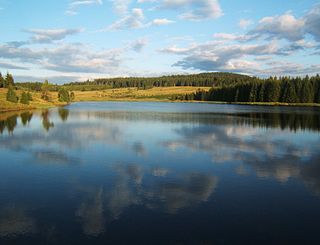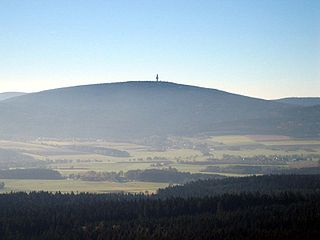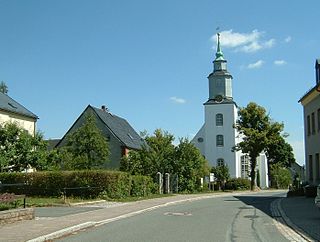
The Ore Mountains lie along the Czech–German border, separating the historical regions of Bohemia in the Czech Republic and Saxony in Germany. The highest peaks are the Klínovec in the Czech Republic at 1,244 metres (4,081 ft) above sea level and the Fichtelberg in Germany at 1,215 metres (3,986 ft).

The Fichtel Mountains is a mountain range in Germany and the Czech Republic. They extend from the valley of the Red Main River in northeastern Bavaria to the Karlovy Vary Region in western Czech Republic. The Fichtel Mountains contain an important nature park, the Fichtel Mountain Nature Park. The Elster Mountains are a part of the Fichtel Mountains.

Schömberg is a spa town in the north of the Black Forest in Baden-Württemberg.

Aue is a small town in Germany at the outlet of the river Schwarzwasser into the river Zwickauer Mulde in the Ore Mountains, and has roughly 16,000 inhabitants. It was merged into the new town Aue-Bad Schlema in January 2019. Aue was the administrative seat of the former district of Aue-Schwarzenberg in Saxony, and is part of the Erzgebirgskreis since August 2008. It belongs to the Silberberg Town League

Schwarzenberg is a town in the district of Erzgebirgskreis in Saxony’s Ore Mountains, near the German–Czech border. The town lies roughly 15 km southeast of Aue, and 35 km southwest of Chemnitz.

Schneeberg is a town in Saxony’s district of Erzgebirgskreis. It has roughly 16,400 inhabitants and belongs to the Town League of Silberberg. It lies 4 km west of Aue, and 17 kilometres (11 mi) southeast of Zwickau.

Johanngeorgenstadt is a mining town in Saxony’s Ore Mountains, 17 km south of Aue, and 27 km northwest of Karlovy Vary. It lies in the district of Erzgebirgskreis, on the border with the Czech Republic, is a state-recognized health resort (Erholungsort), and calls itself Stadt des Schwibbogens. Its population decline since the 1950s has been extremely severe, falling from 45,000 residents in 1953 to only about one twelfth of that now.

The 140-kilometre-long Silver Road is the first and longest holiday route in the German Free State of Saxony. Against the background of the importance of mining in the history of Saxony, the road links those sights and tourist attractions of the Ore Mountains and its foreland that relate to the centuries-old mining and smelting industries of the region.

Bockau is a municipality in the district of Erzgebirgskreis in the Free State of Saxony in Germany. The community is known for growing and researching herbs. Owing to its centuries-old cultivation of angelica, whose roots are used in making liqueurs, Bockau is also known locally by the nickname Wurzelbucke.
Markersbach is a former municipality on the river Große Mittweida in the district of Erzgebirgskreis in Saxony, Germany. Since 1 January 2008, Markersbach and Raschau have formed the municipality of Raschau-Markersbach.

Schönheide is a municipality in Saxony's district of Erzgebirgskreis. It lies in the western Ore Mountains, and was founded as an industrial village.

Schneeberg is the highest mountain in the Fichtel Mountains, a mountain range in Upper Franconia in northeast Bavaria, Germany. It can be readily identified from a distance by its squat tower - a relic of the Cold War. The summit comprises a jumble of granite rocks and a rock pillar (Felsburg) on which the Backöfele observation tower stands and is still dominated by the relics of military installations including its Cold War listening post.

The Harz Club is club dedicated to maintaining the traditions of the Harz mountains in Germany and looking after the walking trails in the Harz. It was founded in 1886 in Seesen and as of 2022 the club has about 16,000 members in approximately 90 branches.

The Fichtelgebirge Club is a large walking club and local heritage society in Bavaria and recognised conservation group with 20,000 members in 55 local groups. As the name says, its main sphere of activity is in the Fichtel Mountains in north Bavaria. Its emblem is the Arctic starflower.
Dreibrüderhöhe or short Brüderhöhe is a mountain of Saxony, southeastern Germany. It is located near Marienberg in Saxony and can reached by a road branching off Bundesstraße 171, or on hiking routes from Marienberg, Wolkenstein, Lauta, Großrückerswalde or Gehringswalde, among them the International Mountain Hiking Route Eisenach-Budapest (EB) which is now part of the E3 European long distance path.

The Kohlhaukuppe is a 786-metre-high (2,579 ft) mountain in the Eastern Ore Mountains near Geising not far from the border with the Czech Republic.

Petrus Albinus was a professor at Wittenberg in Germany and is known as the father of Saxon historiography.

Hundshübel is a village in Erzgebirgskreis district of Saxony, forming a subdivision of the municipality of Stützengrün in the Ore Mountains. It is located north of Eibenstock Dam on federal highway B 169.

The Bavarian Forest Club, or BWV, is a German club that promotes culture, local history and folklore, nature and landscape conservation, and walking in the Bavarian Forest. It has its head office in Zwiesel and is registered in the register of clubs and societies in the district office at Deggendorf.

Rittersgrün is a district of the municipality of Breitenbrunn/Erzgeb. in the Saxon Erzgebirge district. The scattered settlement with around 1600 inhabitants grew up around several hammer mills, which operated on the course of the Pöhlwasser from the 15th to the 19th century and were supplied with ore from numerous surrounding mines. Due to its location on an important Erzgebirge pass, the settlement was repeatedly plundered by passing mercenaries during the Thirty Years' War. After the decline of the hammer mill industry in the middle of the 19th century, the village's economy was dominated by cardboard and sawmills. In 2007, Rittersgrün was incorporated into Breitenbrunn/Erzgeb. Today, Rittersgrün is primarily known as an excursion and winter sports resort. The main attractions include the Saxon Narrow Gauge Railway Museum and a well-developed network of hiking trails.




















